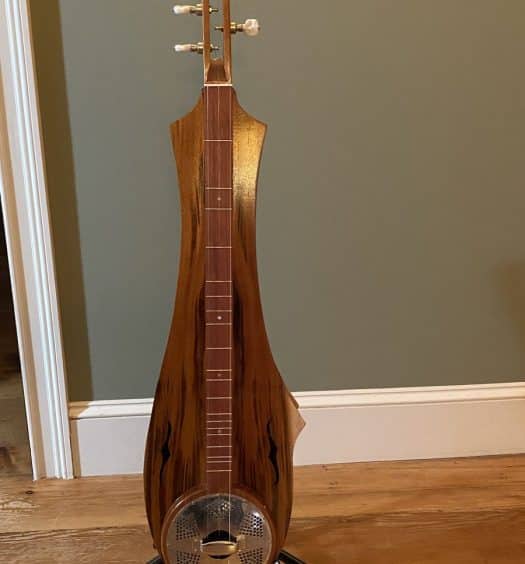There are many things to look for when selecting a mountain dulcimer. While some are important and speak to the quality of the instrument, others are more based on musician taste.
Generally speaking, we recommend speaking to existing mountain dulcimer players – either from a local club, a class, a festival, or at a dealership. These folks should be able to guide you with their experiences. For those who are interested in purchasing a mountain dulcimer online, there are a few things you should consider.
Overall Construction
Mountain dulcimers are beautiful instruments, and are typically shaped like an hourglass or teardrop shape. Some players report that certain shapes can result in different tonal qualities. But in our experience, there are other qualities of the instrument that affect the sound more than the overall shape.
Soundboard Wood Choice
The type of wood used in the top soundboard can have a dramatic effect on the tonal quality of the instrument. Softer woods, such as cedar and spruce, produce a warmer sound while harder woods, such as maple, cherry, or walnut, produce a brighter, crisper sound.
The type of sound produced is entirely based on personal preference. But it helps to know someone who owns a mountain dulcimer so you can play it yourself to determine which sound you most prefer.
Side Depth
Another quality that can affect tonal quality is the depth of the instrument. When comparing mountain dulcimers, those with thicker sides generally produce deeper tones since the resonating cavity is larger in volume. Again, it helps to play different dulcimers side-by-side if possible.
Bridge Placement
The placement of the bridge has evolved over time. Historically, dulcimer builders placed the bridge near the bottom (or “tail”) of the instrument. These are becoming harder and harder to find.
Modern day builders typically place the bridge over the soundboard which gives the instrument more of a guitar-like sound. This is something that mountain dulcimer players are starting to prefer and, as a result, the market is responding accordingly.
String Length
The length of strings that connect the tuning pegs to the bridge (sometimes called vibrating string length) can sometimes affect the playability of the instrument. Typically the string length varies between about 24” to 28”. And that difference of 4” dictates the required spacing between the frets.
In other words, as the length of the strings increase, the spacing between frets increases as well. While this doesn’t necessarily impact the tonal quality of the instrument, it could make it harder to play for those with smaller hands because of the need to stretch your fingers.
Cost
Cost is the most obvious differentiator when choosing mountain dulcimers. For player with some experience under their belt, we recommend going with the most expensive option you can afford. This will ensure an instrument of fine craftsmanship which can be passed down as a family heirloom.
Of course, when first starting out it makes most sense to seek out the most economical option to determine is this is a craft you’d like to pursue.
Final Thoughts
Hopefully this article will help you in deciding what to look when purchasing a new or used mountain dulcimer. Having the ability to test drive some instruments in person – either through a local club, a festival, or dealership – is your best bet. But if not, there are still some great choices available online.
One that we particularly like is the Roosebeck DMCRT4 4-String Cutaway Mountain Dulcimer. Both beginner and experienced players alike have many positive things to say about this instrument. Regardless of which you choose, you’re making an investment in yourself and your musical journey so enjoy the ride.
Interested in learning more about hammered dulcimers? If so, check out our post about the history of mountain dulcimers.




